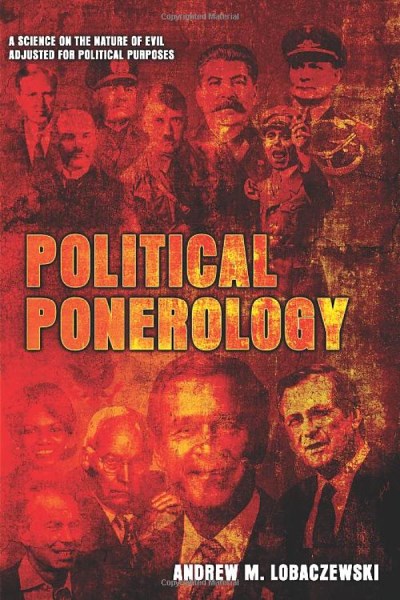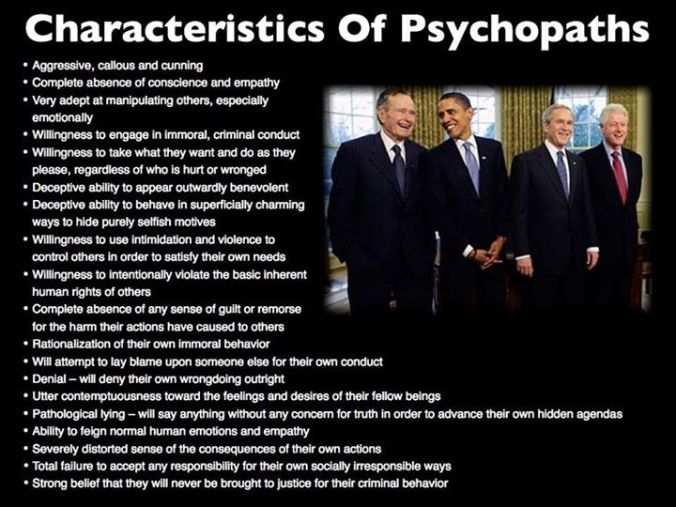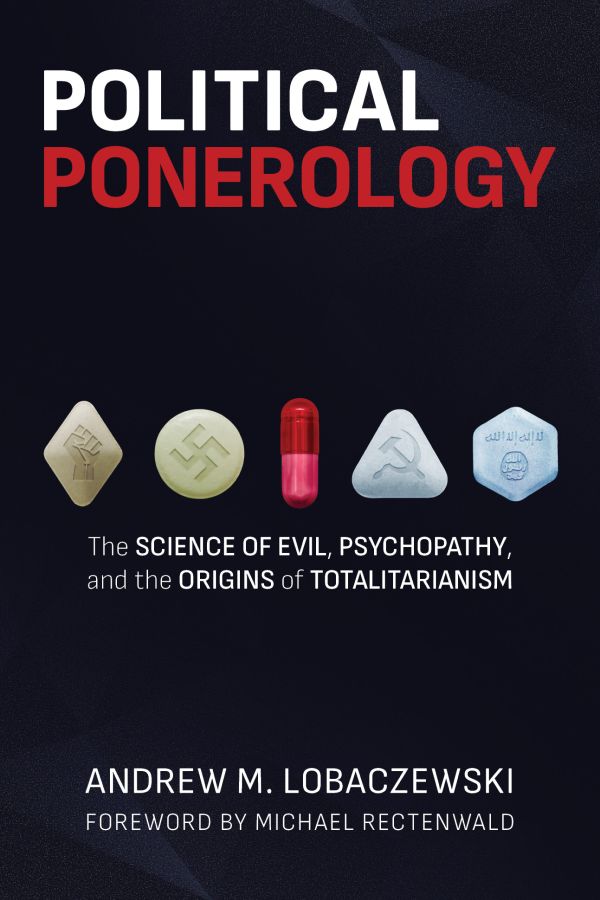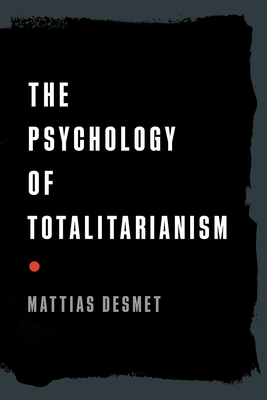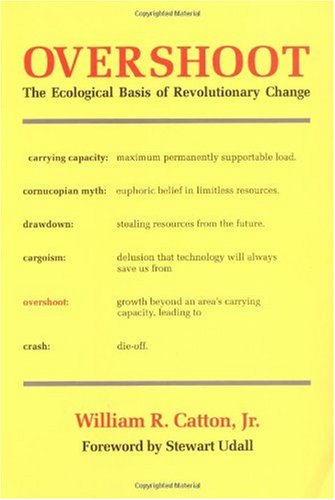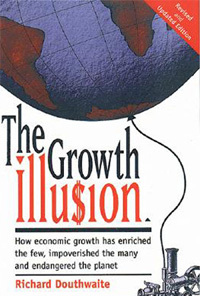“In the author’s opinion, Ponerology reveals itself to be a new branch of science born out of historical need and the most recent accomplishments of medicine and psychology. In light of objective naturalistic language, it studies the causal components and processes of the genesis of evil, regardless of the latter’s social scope. We may attempt to analyze these ponerogenic processes which have given rise to human injustice, armed with proper knowledge, particularly in the area of psychopathology. Again and again, as the reader will discover, in such a study, we meet with the effects of pathological factors whose carriers are people characterized by some degree of various psychological deviations or defects.”(Lobaczewski)
With very few exceptions down the ages, discussions in moral philosophy – the study of right conduct – have failed to systematically investigate the origin, nature, and course of evil in a manner free from supernatural imaginings. Evil was often considered something to be endured rather than something that could be understood and eliminated by rational measures. And – as Lobaczewski demonstrates – the origin of evil actually lies outside the boundaries of the conventional worldview within which the earlier moral inquiries and literary explorations were conducted. Evil requires a truly modern and scientific approach to lay bare its secrets. This approach is called “ponerology”, the study of evil, from the Greek “poneros” = evil.
The original manuscript of this book went into the furnace minutes before a secret police raid in Communist Poland. The second copy, painfully reassembled by scientists working under impossible conditions of violence and repression, was sent via courier to the Vatican. Its receipt was never acknowledged – the manuscript and all valuable data lost. In 1984, the third and final copy was written from memory by the last survivor of the original researchers: Andrew Lobaczewski. Zbigniew Brzezinski blocked its publication.
After half a century of suppression, this book is finally available.
Political Ponerology is shocking in its clinically spare descriptions of the true nature of evil. It is poignant in its more literary passages revealing the immense suffering experienced by the researchers contaminated or destroyed by the disease they were studying.
Political Ponerology is a study of the founders and supporters of oppressive political regimes. Lobaczewski’s approach analyzes the common factors that lead to the propagation of man’s inhumanity to man. Morality and humanism cannot long withstand the predations of this evil. Knowledge of its nature – and its insidious effect on both individuals and groups – is the only antidote.
“Experience has taught the author that evil is similar to disease in nature, although possibly more complex and elusive to our understanding. Its genesis reveals many factors, pathological, especially psychopathological, in character, whose essence medicine and psychology have already studied… [A] comprehension of the essence and genesis of evil generally makes use of data from [biology, medicine, and psychology]. Philosophical reflection alone is insufficient.” (Lobaczewski)
Like a color blind man incapable of distinguishing red from green, a small minority of the human population cannot experience or fully comprehend the normal range of human emotions. And like those color blind who may conceal their condition by using the correct words while not understanding their meaning (e.g., the top traffic light is “red”, the bottom is “green”) – so does this minority conceal their condition by playacting an emotion’s exterior signs (facial expressions, exclamations, body language). However, they do not actually experience the emotion in question. Their deception is revealed in the laboratory, where they respond to words like DEATH, CANCER, DISEASE, as if they were DAY, CREAM, or PAPER. They lack the ability to comprehend the emotional “punch” that certain words contain. They use others’ emotional reactions as cues, and they adjust their behavior to portray the correct ‘emotional’ behavior. (Hare, 129-30)
These individuals are known as psychopaths. Not only can they not feel the pain of others, they often seem to deliberately cause others pain. Lobaczewski refers to this disorder as an “essential psychopathy” to distinguish them from others with deficits in their genetic/instinctual endowment, essential psychopathy being the most severe and disturbing.
Many so-called “antisocial individuals” acquire similar characteristics in their life-time, whether caused by brain damage to certain areas of the brain, or functionally, because of close contact with and influence by such individuals. Lobaczewski terms such individuals characteropaths. The vast majority of both these groups cannot change. The acts that we call evil (especially on a macrosocial level) can be traced back to this deviant minority of human beings and the effects of their actions on their family, friends, and society.
PSYCHOPATHY: THE CAUSE OF EVIL
Inherited and acquired psychological disorders and ignorance of their existence and nature are the primal causes of evil. The magic number of 6% seems to represent the number of humans who either carry the genes responsible for biological evil or who acquire such disorders in the course of their lifetime. This small percent is responsible for the vast majority of human misery and crime, and for infecting others with their flawed view of the world.
The scope of evil does not respect any boundaries of race, doctrine, or ideology. All races carry the genes, and all schools of thought are susceptible to their influence. These pathological factors that influence behaviour form a complex web. It is only in such a web that the “environmental evil” wherein circumstances can influence a normal person to commit harmful acts can be understood.
Of 5000 psychotic, neurotic and healthy patients, Lobaczewski identified 384 (7.7%) who caused serious harm (physical and/or emotional) to others. Some of these had been penalized for their actions and some had been protected by Communist government of the time. Contrary to the common moralistic interpretation of evil actions (“evil consists of making evil choices”), and also contrary to legal systems which views psychopaths as sane and thus responsible for their actions, the vast majority (85%) of these 384 individuals showed psychopathological factors influencing their behaviour. It is likely that, without these factors present, the harmful actions would not have taken place. These psychological factors limit the subject’s ability to control their actions. In this sense, a moralistic interpretation to psychopathic behavior is fundamentally flawed.
While a moral sense (lacking in psychopaths) can be seen as necessary to be held morally responsible, that is not to say that psychopaths should have free rein to destroy lives. Psychopathic individuals can have a number of effects on normal people: they can fascinate, traumatize, cause pathological personality development, or inspire vindictive emotions (a result of viewing evil as simply a “choice”). An example of this variety can be seen in the host of groupies, pen pals, supporters, and love-struck fans that flocks towards dangerous serial killers like Richard Ramirez and Ted Bundy. One fan of Ramirez said, “When I look at him, I see a real handsome guy who just messed up his life because he never had anyone to guide him.”
These effects and the confusion they engender can then lead to, and reinforce our collective ignorance of such individuals. We rarely hold responsible the individual who influences another to commit evil, but instead moralistically punish only the agent of an act. The true cause of ‘evil’ actions goes unpunished, much like an Army Private punished for the crimes of his superiors. In fact, the true source of ‘evil’ may be separated from a specific action by both vast stretches in time (i.e., in literature and tradition) and by large distances (i.e., by mass media).
“The practical value of our natural world view generally ends where psychopathology begins.” (Lobaczewski, 145)
PONEROLOGY: A NEW SCIENCE
No matter how eloquently and accurately authors (novelists, dramatists, poets, historians) describe the occurrence of evil, a disease cannot be cured through description alone. Our natural language cannot adequately explain the concepts surrounding such phenomena. Only a scientific understanding drawing from psychological, social, and moral concepts can approach the understanding necessary to prevent the emergence of mass madness seen so many times in the history of our planet.
Ponerology describes the genesis, existence, and spread of the macrosocial disease called evil. Its causes are traceable and can be repeatedly observed and analyzed. When humanity manages to incorporate this knowledge into its natural worldview, it will have defensive potential as yet unrealized.
THE GENESIS OF EVIL
1. Ponerogenic Associations
2. Ponerization
3. Pathocracy
The ultimate cause of evil lies in the interaction of two human factors: 1) normal human ignorance and weakness and 2) the existence and action of a statistically small (4-8% of the general population) but extremely active group of psychologically deviant individuals. The ignorance of the existence of such psychological differences is the first criterion of ponerogenesis. That is, such ignorance creates an opening whereby such individuals can act undetected.
The presence of such “disease” on the individual level is described in the Almost Human section of this website. However, depending on the type of activity of psychopathic and characteropathic individuals, evil can manifest on any societal level. The greater the scope of the psychopath’s influence, the greater harm done. Thus any group of humans can be infected or “ponerized” by their influence. From families, clubs, churches, businesses, and corporations, to entire nations. The most extreme form of such macrosocial evil is called “pathocracy”.
PONEROGENIC ASSOCIATIONS
“In any society in this world, psychopathic individuals and some of the other deviant types create a ponerogenically active network of common collusions, partially estranged from the community of normal people… Their sense of honor bids them to cheat and revile that ‘other’ human world and its values at every opportunity.” (Lobaczewski, 138)
“We could list various names ascribed to such organizations… gangs, criminal mobs, mafias… which cunningly avoid collision with the law while seeking to gain their own advantage. Such unions frequently aspire to political power in order to impose their expedient legislation upon societies in the name of a suitably prepared ideology, deriving advantages in the form of disproportionate prosperity and the satisfaction for their craving of power.” (Lobaczewski, 158, emphasis added)
“Gangs have always provided great opportunities for young psychopaths. Their impulsive, selfish, callous, egocentric, and aggressive tendencies easily blend in with – and may even se the tone for – many of the gang’s activities. Indeed, there cannot be many other activities that produce so many rewards for violent psychopaths, with such impunity.” (Hare, 176)
Living in a world whose morals and customs are meaningless to them and even seen as oppressive, psychopaths dream of a “happy” and “just” world where their depraved worldview is accepted as reality. They seek, by any means necessary, to achieve positions in government where their dreams can be brought to fruition. If injustice does exist in a society, their statements regarding the ‘unfairness’ of their situation can resonate with those who actually do experience such injustice. Thus, revolutionary doctrines can be accepted by both groups for diametrically opposed reasons.
Ponerogenic groups are those with a statistically high number of pathological individuals, to the point that the group as a whole exercises egotistical and pathological behavior. Deviants function as leaders and ideological spellbinders, and while normal people may act as members, they have typically accumulated various psychological deficiencies. Those not susceptible to such influence are excluded from the group. These groups can either infiltrate existing governments or exert their influence from “behind the scenes.” Bribery, blackmail, murder and similar terror tactics are used to achieve these ends.
Structure: The command structure of ponerogenic associations is similar to that of normal groups: members specialize and complement each other’s strengths. In this way different individuals with varying psychological defects will fill roles in which their particular ‘gift’ is applicable. “The earlier phase of a ponerogenic union’s activity is usually dominated by characteropathic, particularly paranoid individuals, who often play an inspirational or spellbinding role in the ponerization process. Recall here that the power of the paranoid characteropath lies in that they easily enslave less critical minds” (Lobaczewski, 162). Trauma victims, individuals with psychological deficiencies, and young people often fall into the category of ‘less critical minds’.
Ideological Mask: The group’s stated goals are often at variance with its true nature. Colorful literature and humanitarian values often mask its true motivations. Take, for example, the disparity between the CIA’s stated goals, such as “Creating special, multidisciplinary centers to address such high-priority issues such as nonproliferation, counterterrorism, counterintelligence, international organized crime and narcotics trafficking, environment, and arms control intelligence”, and its widespread use of terrorism, torture, overthrowing democratically elected governments, installing foreign dictators, drug trafficking, arms smuggling, etc. Also, compare the public humanitarian front of the Anti-Defamation League with its sordid history of illegal domestic surveillance, character assassination, and collaboration with foreign spy organizations.
First Criterion of Ponerogenesis: “One phenomenon all ponerogenic groups and associations have in common is the fact that their members lose (or have already lost) the capacity to perceive pathological individuals as such, interpreting their behavior in fascinated, heroic, or melodramatic ways” (Lobaczewski, 158). When a group has succumbed to pathological influence its members soon lose the ability to distinguish normal human behavior from pathological. This atrophy of critical faculties in relation to such individuals becomes an opening to their activities. It can also be used to identify potentially dangerous groups.
Characteropathy and Psychopathy: Groups dominated by characteropaths engage in fairly primitive activities, and are thus easily broken by normal society. Psychopathic leaders, however, are often more clever, and use characteropathic individuals as subservient tools. When arrested, such individuals accept the paramoral ideals of their leaders, acting as the group’s scapegoat and accepting the majority of the blame. Psychopathic leaders, when in court, will correspondingly shift the blame to their underlings. A large-scale example of this dynamic is the scapegoating of low-ranking military officers for war crimes condoned and/or ordered by higher-ranking authorities.
Primary and Secondary Ponerogenic Unions: There are two types of ponerogenic associations. Primary ponerogenic associations are those that were originally formed and designed to benefit its founding members using illicit (evil) means. Lobaczewski describes them as unions “whose abnormal members were active from the very beginning, playing the role of crystallizing catalysts as early as the process of creation of the group occurred,” e.g. criminal gangs (160). Such groups’ antisocial activities and blatant disregard for moral values naturally disgust normal people, and thus their influence does not spread far before they lose their battle with society.
The secondary ponerogenic associations are groups founded with an independent and attractive social ideal, but which later succumb to moral degeneration. This degeneration leaves an opening for “infection and activation of the pathological factors within, and later to a ponerization of the group as a whole, or often its fraction” (Lobaczewski, 160). Governments, ideologies, and religions are institutions founded by people whose lack of awareness of specific psychological realities and other moral failings leave them open to covert infection and subsequent take-over by those without conscience. The fact that these institutions have been in existence and have a long-standing tradition has allowed them to acquire a much greater membership and notoriety. When such an organization, working towards some social or political goal, is already accepted by a large number of normal people (e.g. American Republicanism or Evangelical Christianity), ponerization of the group provides the widespread influence that primary ponerogenic unions lack.
After its takeover by psychopathic elements within (e.g. the Neoconservative takeover of American Republicanism), the ponerogenic group is protected by a “mask” of the group’s traditional values. This will happen in spite of the fact that these values are obviously distorted and disregarded. For example, such a group will pass legislation and behave solely to benefit those in control, often becoming violent and starting wars of aggression. Normal members of such a group naively protect such deviant behavior, not realizing it is the work of deviants. Its pathology remains hidden by those who do not wish to see it objectively. Justifications and prepared ideologies are promulgated; subconscious selection and substitution take place, and the pathology is effectively cloaked behind a mask of sanity. Those who belong to ‘the party’ will label the opposition as pacifists, socialists, liberals or terrorists, or whichever label is most effective in order to invalidate their criticism. Unfortunately the government will only become more pathological in its behavior and egotistical toward other nations until the deviant psychological aspects are either purged or destroy themselves.
The same dynamic plays out in interpersonal relations. Take, for example, Ted Bundy, who had a reputation as a kind, intelligent, respectable man. When he was first accused of murdering several young women, his acquaintances staunchly defended his character. This situation follows the same pattern as the macrosocial dynamic. Such individuals will often denigrate the victims and accusers of such a previously esteemed individual. This not only has a negative effect on the victim, but encourages further deviant behavior on behalf of the perpetrator.
Macrosocial Disease: Social disease may be called macrosocial under either of two conditions: 1) ponerogenic processes encompass a society’s entire ruling class, or 2) opposition from normal people is stifled, via the mass use of spellbinding, censorship, and physical compulsion. Two general stages of macrosocial disease seem to apply to all its forms and variations: hysteria and pathocracy.
PONERIZATION
The first step in the ponerization of a group often appears as a moral distortion of the group’s original ideology. The existence of simplistic concepts (e.g., whether moral or legal) blocks any ability for critical thought in relation to the existence of psychopaths or their possible influence on the initial warping of the group’s ideology. Such doctrinaire concepts are prevalent in the neoconservative ideology. For example, “You’re either with us or against us (in the War on Terror)” and the completely arbitrary use of the labels “terrorist,” “terrorist sympathizer”, and “suspected terrorist.”
Just as it is normal in the life of any human to experience a decline in psychological or physiological resistance (thus leading to moral failings or bacteriological infection), groups experience such crises. The pressure leading to such crises may be caused by the influence of other groups, a heightened hysterical condition, or a general spiritual crisis in the environment.
The resulting weakness in proper reasoning and critical thinking skills leaves an opening for the activity of psychopaths and characteropaths. Their influence then results in a further decline in moral and intellectual functioning. The absurdity of such a dynamic can be seen in the fact that Richard Cheney, an obvious psychopath, is allowed to hold the position of vice-president. Even when he shoots a hunting partner in the face, the media and public will studiously rationalize his coarse and psychopathic behavior. (See Dave McGowan’s analysis of the incident in question.)
When such individuals are treated as normal, more perceptive individuals will leave the group. When the group has become sufficiently pathological, members will either perceive its new direction in moral terms (e.g., “We must kill them all on the principle of justice and democracy”), or as a form of psychological terror. As more healthy people leave the group, taking on more counter-revolutionary positions, individuals with psychological anomalies join, removing their masks of sanity ever more often. Without adequate knowledge, normal individuals who have been ejected from such a group will suffer immensely, cut off from their original ideological reason for joining. Infected with unhealthy emotions and pathological material, they can assume positions opposite to those which they formerly followed.
New members are psychologically screened. No one with too much independence or psychological normality is allowed in the group. (Such screening should have taken place to root out psychological deviants in the first place.) Detractors are treated with paramoral condemnation. In short, the patients have overtaken the asylum.
Stages of Ponerization: When it is first infected by psychological deviants, the group maintains most of its original character. But eventually, the more normal members are pushed into fringe functions and are excluded from organizational secrets; some of them thereupon leave the group. “Individuals with inherited deviations then progressively take over the inspirational and leadership positions. The role of essential psychopaths gradually grows, although they like to remain ostensibly in the shadows… In ponerogenic unions on the largest social scale, the leadership role is generally played by a different kind of individual, one more easily digestible and representative. Examples include frontal characteropathy, or some more discreet complex of lesser traits.” (Lobaczewski, 162)
The initial stage of ponerization, where membership is increasingly pathological, requires specific psychological and factual knowledge in order to recognize. The second, more stable and overtly pathological stage, is readily apparent to most normal people, but is interpreted in moral or sociological terms (i.e., without knowledge of psychological differences).
Over time, as the group becomes more heavily ponerized, the spellbinders who originally led such a group are relegated to the task of repackaging the ideology for propaganda purposes. The leadership roles become saturated with more psychopathic individuals, while the “normal” group acquires more characteropathic individuals.
As is the case with the Neoconservative ponerogenic union’s ostensible “unitary executive” George W. Bush, group propaganda maintains the erroneous overestimation of the ‘leader’s’ real power. This leader “is dependent upon the interests of the union, especially the elite initiates, to an extent greater than he himself knows. He wages a constant position-jockeying battle; he is an actor with a director. In macrosocial unions, this position is generally occupied by a more representative individual not deprived of certain critical faculties; initiating him into allthose plans and criminal calculations would be counterproductive. In conjunction with part of the elite, a group of psychopathic individuals hiding behind the scenes steers the leader, the way Borman and his clique steered Hitler. If the leader does not fulfill his assigned role, he generally knows that the clique representing the elite of the union is in a position to kill or otherwise remove him.” In such a manner, George W. Bush is steered and controlled by a group of psychopathic advisors: Richard Perle to name but one.
PATHOCRACY
The first phase of macrosocial disease, i.e. social hysterization, is the opening through which pathocracy manifests. Such a period of societal spiritual crisis is associated with the exhausting of the ideational, moral, and religious values heretofore nourishing the society in question. Individuals and groups grow increasingly self-serving, and the links of moral duty and social networks loosen. People become concerned with trifling things, ignoring more important issues such as commitment to the future, or involvement in public matters.
The most characteristic feature of such a period is widespread hysteria, like that of the quarter century in Europe preceding WWI. “Happy” times of peace are necessarily dependant on social injustice, and children of the privileged class learn early to repress ideas that they and their families are benefiting from the injustice of others. Such unconscious defense mechanisms cause these individuals to disparage the values of those whose work they exploit. These processes lead to an hysterical state of inhibited logic and reasoning. This rigidity of thought then gets passed on to the next generation to an even greater degree.
The hysterical patterns finally get passed from the ruling class to the less privileged classes. This characteristic contempt for factual criticism, for normal thought patterns and nations, obviates the need for media censorship. A pathologically hypersensitive censor lives within each citizen. This has been repeatedly demonstrated by the American media in relation to the omissions and distortions of the Kean-Zelikow 911 Commission Report, the propaganda leading to the Iraq war, the death toll of Iraqi citizens, the reality in Palestine.
“When three “egos” govern – egoism, egotism, and egocentrism – the feeling of social links and responsibility toward others disappear, and the society in question splinters into groups ever more hostile to each other. When a hysterical environment stops differentiating the opinions of limited, not-quite-normal people from those of normal, reasonable persons, this opens the door for activation of the pathological factors of a various nature to enter in.” (Lobaczewski, 177)
This hysteroidal phase is often followed by a period of war, revolution, genocide, and the fall of empires: pathocracy.
REVIEWS
PHILIP ZIMBARDO, Professor Emeritus of Psychology, Stanford University, and author of The Lucifer Effect, writes:
“I was most impressed with the combination of depth and breadth in this treatment of evil; depth in the search for and elucidation of the sources or origins of different kinds of evil and of the systems that generate and perpetuate evil, and breadth in the rich reach of ideas across many domains of knowledge. Together they combine to make fascinating, essential reading.”
ILAN PAPPE, Professor of History, University of Exeter, and author of The Ethnic Cleansing of Palestine, writes:
“This is an extraordinary book. I cannot judge the biological aspects of the tyrannical few who rule political and economic elites in the modern era, but intuitively I am convinced that it is a pathological condition. The analysis and prognosis offered in this book rang true and valid again and again when I thought about my own work, both with regards to [the Nakba of] 1948 and … the history of the Israeli occupation.”
For More Information See:
Interview with Andrew M. Lobaczewski
Political Ponerology by Andrew M. Lobaczewski

